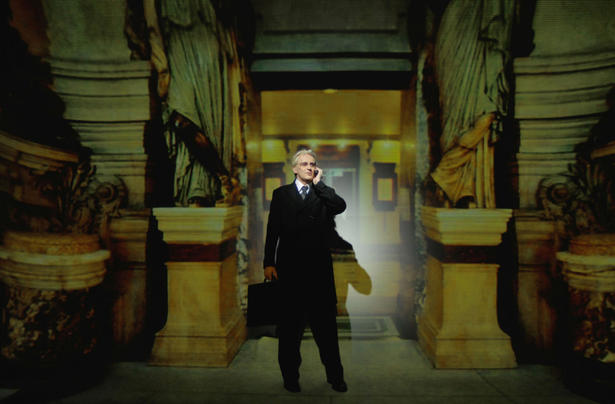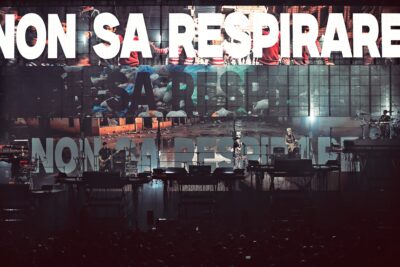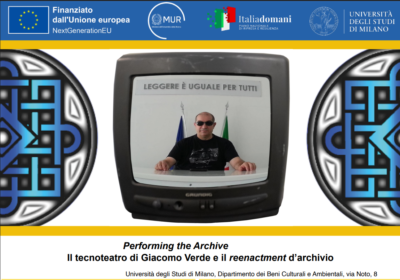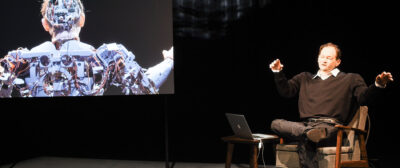Canadian Theatre Review
Vol. 172, Fall 2017
CTR Online: http://bit.ly/ctrV172
Articulating Artistic Research
Features:
“Introduction: Ahr-tik-yuh-leay-ting Ahr-tis-tik Ree-surch”
Bruce Barton http://bit.ly/ctr72int
“What Happens When…?”: A Meditation on Experimentation and Communication in Practices of Artistic Research
Natalia Esling’s introductory article to this special issue of CTR offers a snapshot of views and experiences of an international colleague (Falk Hübner) as a point of comparison for her own experiences using practice-based research (PBR) methodologies to examine the impact of sensory manipulation in contemporary performance. Discussing in brief her own research methods and experiment design, she considers several fundamental criteria associated with Artistic Research (AR)—process orientation, knowledge generation, and utility/transferability—arguing that the significance of discoveries made and knowledges gained through practices of AR lies in the capacity to communicate those discoveries and knowledges across multi- and interdisciplinary boundaries. The article further articulates the benefit of hands-on processes that lead to more incisive and precise questions related to discrete aspects of the dynamics of performance; it considers a way of thinking about AR in relation to performances/productions that does not necessarily privilege a performance/production as a final “outcome,” but rather that positions it as one aspect within the broader process of addressing a particular question through AR.http://bit.ly/ctr172b
Work Quickly but Think Slowly
Brian Quirt reviews the history, impact, and current activities related to Nightswimming’s Pure Research program in the context of his own creative practice. The article examines the program’s impact in light of current partnerships with four Nordic theatre research organizations, relating performance lab work conducted in 2016 in Reykjavik, Iceland, to Quirt’s own practice as a dramaturg and theatremaker. The article assesses Nightswimming’s ongoing efforts to archive past research projects, disseminate the results, and by examining the impact of those projects on participating artists, strategize about future Pure Research iterations. Most importantly, the article explores the relationship between Pure Research’s commitment to ‘pure’ performance research, and how its activities and discoveries have had significant impact on how Nightswimming initiates new creative projects and designs the creation process for those works in development. The article refers to a previous CTR article devoted to Pure Research, published in CTR 119 (Summer 2004) also written by Quirt.http://bit.ly/ctr172c
Connective Tissue: Practice as Research in Cross-disciplinary Research Collaborations
Practice as Research (PaR and its associated forms) is becoming established within a knowledge paradigm encompassing a broad spectrum of different artistic research practices in the performing arts. In this short essay, Hansen first acknowledges and describes methodological characteristics of this work, which appear across different discussions and examples. The author’s primary objectives, however, are to look at PaR in relationship to broadly established scientific and interpretive research paradigms; to identify the points of negotiation that cross-disciplinary research entails; and to discuss the additional capacity of PaR as ‘connective tissue’ between, for example, creative practice and scientific research. These objectives are driven by the observation that contemporary socio-environmental challenges are too complex to be addressed through segregated, discipline-specific research alone.http://bit.ly/ctr172d
The Larval Journey
How does a creating theatre artist access inspiration; how are they able to push the bounds of their current practice and find news of working; how do they get to an original idea? This article might not be able to solve those direct questions but provides avenues toward the possibility of answers. We explore the abstract form in Larval Mask as well as larval shape to goad both our mind and body into the unknown fog of the creative cosmos, to see what happens when we release the pursuit of reaching for a predetermined “idea” and to simply explore the arrival of something unexpected. In this manner of process we are able to push the status quo on many different forms of theatre—in this case toward the advancement of puppetry. http://bit.ly/ctr172e
“[So] What Do Dancers Know, [Anyway]?”: Voicing the Dancer’s Perspective through Emergent Choreographic Analysis
[So] what do dancers know, [anyway]? Part manifesto, part essay, this article presents a woven, multi-level text discussion of my dancer/scholar standpoint and practice-as-research approach to articulating the dancer’s perspective. My recent research develops an emergent choreographic analysis of iconic American dance artist Deborah Hay’s choreography and practice, from my first-person experience as practitioner/performer in her solo “At Once” (2009). Writing as closely as possible to the dancing experience from within the practice, and using phenomenological, critical-poetic and performative writing strategies, this approach involves an iterative practicing, performing, and writing process that echoes the principles of adaptation underlying Hay’s own project. Reflecting Robin Nelson’s proposal that, in PaR, theory is imbricated within practice but must be articulated in complementary writing, I draw on Linda Hutcheon’s definition and principles of adaptation as a tool to amplify the resonances between Hay’s work, my artistic research itself, and the framework for its articulation. I ultimately position my research and writing not as a separate analytical reflection but as a critical-creative adaptation of Hay’s choreographic work. http://bit.ly/ctr172f
A Way to Work on My Problem without Knowing What It Is
The article outlines the background, development, method and impact of performance encyclopaedia, an iterative performance work co-created by Ame Henderson and Evan Webber. performance encyclopaedia, proposes that reading and writing are convivial, choreographic actions that produce not objects but temporal, collective, and embodied experience. The inception of this project is connected to a reading of Artistic research: theories, methods and practices by Mika Hannula, Juha Suoranta, and Tere Vadén, which was a major influence on the creators’ thinking. http://bit.ly/ctr172g
Rhythm and Rumination: A Three-Course Conversation
This article examines “specific productions” or products as these notions are called into question through artistic research. It reports on a pedagogical experiment that I conducted with a group of eighty students at Concordia University in the fall of 2016. Through writing, photography, and video, I document and reflect upon the relationships between pedagogy, research, and artistic production. These samples show that there are problems with attempting to distinguish between everyday acts and finished works. The process documented in the article calls into question the boundaries that we imagine between educating and artistic research. It does so by demonstrating the creative role of the educator in eliciting dialogue through the senses and in directing dialogue through attention to rhythm. http://bit.ly/ctr172h
Of Puppets and Prototypes—Proposals for an Intermedial Performance Design Practice
In this brief essay, puppetry serves as a metaphor for thinking about how several design research techniques—such as participatory prototyping or the development of user requirement specifications—may be adapted to the collective creation of intermedial performance projects. The observations and speculations explored in this essay have emerged primarily through the author’s own experiences as a designer of intermedial performance instruments over the past decade. As such, this essay constitutes a personalized proposal for an improved set of working methods capable of identifying and avoiding several recurring processual tendencies. http://bit.ly/ctr172i
The Invisible Opportunity: All the Light We Cannot See (in Research)
This article articulates the growth that occurs in graduate school when the author comes to terms with their disability as being a positive contribution to their scholarly work by using it in practice-based and embodied research. It explores a project which illuminated the possibilities of embodied research by renegotiating the emphasis of visual performance on stage and by claiming space in graduate life to work with disability to bring new perspectives to scholarly work. http://bit.ly/ctr172j
To ‘Hack’ and Back: The Professional Actor as Researcher
This article examines the idea of “articulating artistic practice” from the positionality of professional actors who also work as researchers within a practice-based research framework. Three main areas of concern are briefly outlined and unpacked: remuneration, scheduling, and aesthetic/practical goals and outcomes. Practice-based research is, by definition, interdisciplinary, and often intermedial. Highlighting some of the commonalities and differences that exist between professional performance practitioners and academic researchers is a necessary and fertile exercise in the quest to establish working methodologies and successful collaborations within the broader praxis of research models based in performance behaviours and technique. http://bit.ly/ctr172k
Photo Collection
Emerging to established Toronto dance artists respond to the question: “How is your artistic research or creative process different when there is no deadline associated with the project?” http://bit.ly/ctr172l
A Practitioner’s Attempt at Quantifying the Actor’s Experience
This article outlines selected findings from a personal research project I conducted in 2012 in Toronto with support from Nightswimming Theatre’s Pure Research Program—a program for professional artists to investigate questions within their practice free from any outside academic or performance agenda. I conducted a two-day performance lab with eighteen actors to investigate the experience of acting in different performance mediums and the usefulness of the Visual Analogue Scale to quantify this experience. http://bit.ly/ctr172m
Practice and Research: A Report from the Academy
Patrick Blenkarn, Cole Lewis, Ker Wells
Summarizing a round-table discussion by faculty members at Simon Fraser University’s School for the Contemporary Arts, this report presents the arguments and assumptions surrounding Practice as Research within the university. The artists present, drawing from their own experiences in a range of disciplines, debate the terminologies of research, institutional conceptions of methodologies, the function of documentation, their relationship with artists outside of the university system, and the place of teaching within the (potentially false) binary of practice and research. While no ultimate conclusions are made, the report serves as a condensed survey of the significant methodological, if not cultural, divides within contemporary art as it exists within the university institution. http://bit.ly/ctr172n
Listening to Animals: Interspecies Understandings through Performance-Based Research
Kimber Sider
We live in an interspecies community, and yet much of the time only human perspectives are acknowledged or considered valid. In order for animal perspectives to be recognized, the mode of inquiry needs to privilege animal ways of knowing and being in the world; it needs to privilege performance, and practice-based research. This paper explores the potential and importance of engaging performance-based research in interspecies contexts. The analysis centers on the performance-based research project, Playing in Silence, which invites musicians to improvise with horses in an open and unstructured space. Playing in Silence demonstrates that through the shared language of performance, humans and horses can co-create understandings, expand knowledges, and learn about one another. Many humans spend an inordinate amount of time speaking about animals, but completely overlook the possibilities of speaking with animals, of learning with and from them, and of discovering their perspectives as unique individuals. However, by tuning into the nuances of another’s performance, through the reflexive inquiry of performance-based research, interspecies understandings can be found, challenging the dominant human-centric perspective of the world, and opening up new realms of understanding. http://bit.ly/ctr172o
Interactive Research: Media | Animator | Performer
Gwenyth Dobie, William Mackwood
This article investigates the emerging methodologies of interactive performance. Interactive performance has been defined as one in which: digital technology is a central strategy, andthere is a corporeal presence (live body) on stage, and there is real-time interactivity between the two. The central question of this study revolves around the evolving systems used to develop this work, specifically searching for solutions to the complex challenges raised when developing digital tools synergistically with dramatic content. As artistic researchers and educators in the School of the Arts, Media, Performance and Design, York University, and Artistic Directors of Out of the Box Productions, Gwenyth Dobie and William Mackwood are advantageously positioned to use creative practice as a primary means and method of inquiry. Through their research-creation work they recognize the general term “Animator” as better able to describe the blend of knowledge, interests, and investment needed of all participants for a successful outcome. Further, they implement the terms “Animator Performer” (AP) and “Media Animator” (MA) when working in the world of interactive performance. From the findings on their most recent immersive piece Rallentando — an Installation, Dobie and Mackwood detail new creation methodologies where Media Animator/Animator Performer collaborate in ‘real-time’ throughout the developmental process. http://bit.ly/ctr172p
Terms of Engagement: The Ethics and Aesthetics of Artistic Experimentation in the Rencontres/Encounters Project. A Dialogue of Sorts
Rachael Van Fossen, Lisa Ndejuru
Situated within a context of social unease around xenophobic measures such as Québec’s Commission on Reasonable Accommodation and the infamous Charter of Québec Values, Rencontres/Encounters (R/E)’s research-creation process foregrounds what Ric Knowles terms “interculturalism” or “the contested, unsettling, and often unequal spaces between cultures, spaces that can function as performative sites of negotiation.” R/E blurs distinctions of what constitutes “community-engaged,” by experimenting with professional theatre artists from diverse or marginalized communities as an ethical, experimental approach to advancing social engagement processes and artistic creation. Can stepping into performance in the stories of others/another/an Other help build relationships and transform understandings across different life experiences, value systems, racialization, faiths, sexual and gender identities, etc.? The basis of the R/E experimental methodology in studio was to invite performance proposals centred on an ever-evolving set of questions. For example: What personal material can and should be used? How can risks be mitigated in future encounters? What are we looking for? How can we clarify the terms of engagement? Our team now is refining and adapting the experiments for dissemination in the form of workshops, and through a resource guide that will provide a menu of exercises, games, and performance proposals. http://bit.ly/ctr172q
The Making of Making Treaty 7: A Practical, Philosophical and Ideological Template for Intercultural Collaboration
Troy Emery Twigg, Kris Demeanor, Bruce Barton
The origins of Making Treaty 7 the theatrical production in some ways mirror the treaty signing process itself 140 years ago: Negotiation, protocol, and the quest of two cultures trying to understand each other. Where this process significantly diverges from the murky dealings in 1877 is that the spirit in which this society and this play were created comes out of a need to repair and reconcile the fractured relationship between the First Nations and “newcomers,” a desire to recognize the facts of the past and have it inform us as to how to move forward together on this land. This article is a unique look inside the genesis and creation of Making Treaty 7. Troy Emery Twigg, a Blackfoot artist, dancer, and educator, and Kris Demeanor, a Calgary-based poet and musician, were part of the initial wave of consultation with Treaty 7 elders, research, and discussion with Michael Green, Narcisse Blood, and Blake Brooker that helped define the trajectory of Making Treaty 7. These interviews illuminate how research, largely based on written versions of first hand oral accounts by First Nations leaders, stimulated the artistic process as “theme bundles” were created and as musical and scene creation collaborations were pursued. Ultimately, it is the story of reconciliation through art, and the blending of socially conscious creation with artistic rigour. http://bit.ly/ctr172r
Script
Collective Script
Kimber Sider, Ker Wells, Natalie Doonan, P. Megan Andrews, Peter Balkwill, Christine Brubaker, Martin Julien
One of the most complex and complicated aspects of Artistic Research lies in its relationship to documentation, dissemination, and transferability. How does one represent process without turning it into a product? This issue’s ‘script’ is the manifestation of that challenge, a collaboratively realized project that is both a research design and its realization, a material process that is also a work of art. http://bit.ly/ctr172s
For a full list of views and reviews: http://bit.ly/ctrV172
For more information about the Canadian Theatre Review or for submissions information, please contact:
University of Toronto Press – Journals Division
5201 Dufferin St., Toronto, ON, Canada M3H 5T8
Tel: (416) 667-7810 Fax: (416) 667-7881
Fax Toll Free in North America 1-800-221-9985





